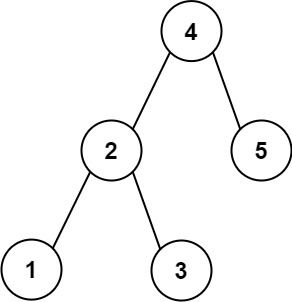Welcome to Subscribe On Youtube
270. Closest Binary Search Tree Value
Description
Given the root of a binary search tree and a target value, return the value in the BST that is closest to the target. If there are multiple answers, print the smallest.
Example 1:

Input: root = [4,2,5,1,3], target = 3.714286 Output: 4
Example 2:
Input: root = [1], target = 4.428571 Output: 1
Constraints:
- The number of nodes in the tree is in the range
[1, 104]. 0 <= Node.val <= 109-109 <= target <= 109
Solutions
Binary search.
Use the characteristics of the binary search tree (left<root<right) to quickly locate, because the root node is an intermediate value,
When we traverse down, we compare according to the relationship between the target value and the value of the root node.
If the target value is less than the node value, we should find a smaller value, so we go to the left subtree to find, otherwise we go to the right subtree to find.
-
/** * Definition for a binary tree node. * public class TreeNode { * int val; * TreeNode left; * TreeNode right; * TreeNode() {} * TreeNode(int val) { this.val = val; } * TreeNode(int val, TreeNode left, TreeNode right) { * this.val = val; * this.left = left; * this.right = right; * } * } */ class Solution { public int closestValue(TreeNode root, double target) { int ans = root.val; double mi = Double.MAX_VALUE; while (root != null) { double t = Math.abs(root.val - target); if (t < mi || (t == mi && root.val < ans)) { mi = t; ans = root.val; } if (root.val > target) { root = root.left; } else { root = root.right; } } return ans; } } -
/** * Definition for a binary tree node. * struct TreeNode { * int val; * TreeNode *left; * TreeNode *right; * TreeNode() : val(0), left(nullptr), right(nullptr) {} * TreeNode(int x) : val(x), left(nullptr), right(nullptr) {} * TreeNode(int x, TreeNode *left, TreeNode *right) : val(x), left(left), right(right) {} * }; */ class Solution { public: int closestValue(TreeNode* root, double target) { int ans = root->val; double mi = INT_MAX; while (root) { double t = abs(root->val - target); if (t < mi || (t == mi && root->val < ans)) { mi = t; ans = root->val; } if (root->val > target) { root = root->left; } else { root = root->right; } } return ans; } }; -
# Definition for a binary tree node. # class TreeNode(object): # def __init__(self, x): # self.val = x # self.left = None # self.right = None class Solution(object): def closestValue(self, p, target): """ :type root: TreeNode :type target: float :rtype: int """ ans = p.val while p: if abs(target - p.val) < abs(ans - target): ans = p.val if target < p.val: p = p.left else: p = p.right return ans ############ # Definition for a binary tree node. # class TreeNode: # def __init__(self, val=0, left=None, right=None): # self.val = val # self.left = left # self.right = right class Solution: def closestValue(self, root: Optional[TreeNode], target: float) -> int: ans, mi = root.val, inf while root: t = abs(root.val - target) if t < mi: mi = t ans = root.val if root.val > target: root = root.left else: root = root.right return ans -
/** * Definition for a binary tree node. * type TreeNode struct { * Val int * Left *TreeNode * Right *TreeNode * } */ func closestValue(root *TreeNode, target float64) int { ans := root.Val mi := math.MaxFloat64 for root != nil { t := math.Abs(float64(root.Val) - target) if t < mi || (t == mi && root.Val < ans) { mi = t ans = root.Val } if float64(root.Val) > target { root = root.Left } else { root = root.Right } } return ans } -
/** * Definition for a binary tree node. * function TreeNode(val, left, right) { * this.val = (val===undefined ? 0 : val) * this.left = (left===undefined ? null : left) * this.right = (right===undefined ? null : right) * } */ /** * @param {TreeNode} root * @param {number} target * @return {number} */ var closestValue = function (root, target) { let ans = root.val; let mi = Number.MAX_VALUE; while (root) { const t = Math.abs(root.val - target); if (t < mi || (t === mi && root.val < ans)) { mi = t; ans = root.val; } if (root.val > target) { root = root.left; } else { root = root.right; } } return ans; }; -
/** * Definition for a binary tree node. * class TreeNode { * val: number * left: TreeNode | null * right: TreeNode | null * constructor(val?: number, left?: TreeNode | null, right?: TreeNode | null) { * this.val = (val===undefined ? 0 : val) * this.left = (left===undefined ? null : left) * this.right = (right===undefined ? null : right) * } * } */ function closestValue(root: TreeNode | null, target: number): number { let ans = 0; let diff = Number.POSITIVE_INFINITY; const dfs = (node: TreeNode | null): void => { if (!node) { return; } const nxt = Math.abs(target - node.val); if (nxt < diff || (nxt === diff && node.val < ans)) { diff = nxt; ans = node.val; } node = target < node.val ? node.left : node.right; dfs(node); }; dfs(root); return ans; }